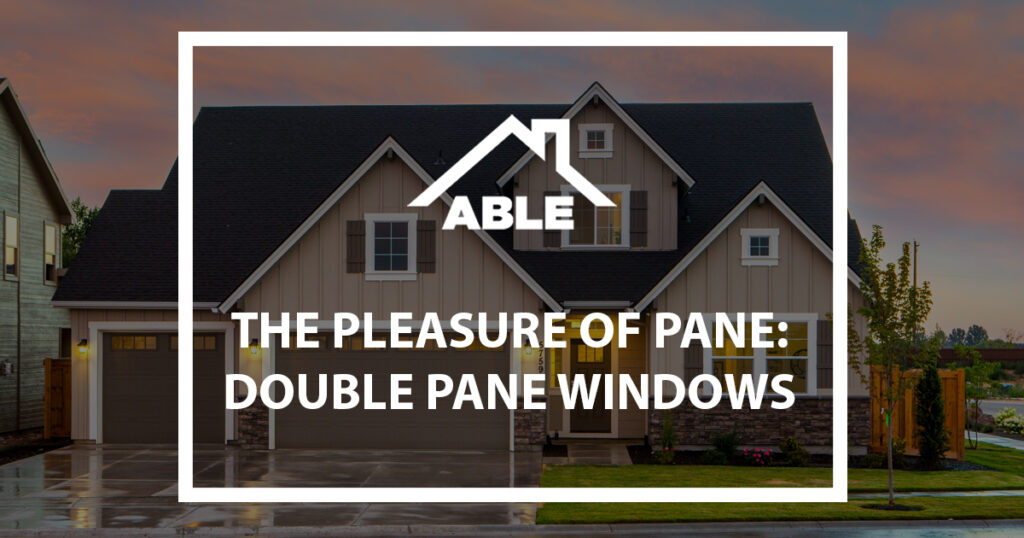If you’re in the market for new windows and looking for a window installation service, you may be aware of the multiple types of windows available to you. Though vendors commonly offer single pane, double pane, and even triple pane windows, the double pane is the industry standard for a reason.
How did windows, as we know them, come about? Why are double pane windows so popular? Most importantly, why should you choose double pane windows over the alternatives? This brief guide to double pane windows will answer these questions and more.
The Evolution of Windows
Windows, as we know them, have been a long time coming. Since the early European cathedrals utilized lead-soldered stained glass, people have been looking for a way to allow the outdoors – along with natural light – inside. Northern Europeans went so far as to cut small holes, known as wind eyes, into their homes for ventilation. These vents, covered only in shutters, paper, or hide leather, served their purpose.
However, it wasn’t until the 19th century that sheets of clear glass became available in the United States. The Pittsburgh Plate Glass company made plate glass windows available to the masses, banking on the affordability of their automated process. These glass wind eyes became known as windows, and the next evolution in windows didn’t come for another hundred years or so.
How Did Double Pane Windows Evolve?
 In the 1920s and 30s, owners and builders of skyscrapers everywhere from New York to Chicago to Los Angeles were looking for a way to reduce the heat loss and energy costs that plagued the taller buildings’ vast expanses of single pane glass. As each window failed, double-glazed insulated glass units designed to prevent heat transfer replaced them.
In the 1920s and 30s, owners and builders of skyscrapers everywhere from New York to Chicago to Los Angeles were looking for a way to reduce the heat loss and energy costs that plagued the taller buildings’ vast expanses of single pane glass. As each window failed, double-glazed insulated glass units designed to prevent heat transfer replaced them.
As late as the early 1950s, however, homeowners had but one choice when looking for new or replacement windows for their homes. Single pane windows were the industry standard, and homeowners wanting to provide extra insulation had to install storm windows that attached to the exterior of the home in order to prevent heat transfer and provide protection against the elements.
In 1947, Pittsburgh Plate Glass produced a double-paned, insulated glass window for passenger train cars. By 1952, Andersen Lumber Company introduced a consumer window with welded, insulated glass. Both developments sparked a revolution in window-making that would eventually change the industry forever. By the late 1970s, the energy crisis in the United States had reached its peak, prompting the US government to begin performing research on higher performing glass to solve its energy woes and putting energy efficient windows into the hands of more consumers.
What Are Double Pane Windows?
Although single pane windows are still on the market, most experts recommend the use of double pane windows. What is a double pane window? Why are they so beneficial?
Double pane windows, at their most basic, are windows with two panes of glass instead of the traditional single pane. Space left between the panes provides additional heat and sound barrier between your home and the outdoors. Then, a desiccant between the panes prevents condensation from building up in the interior. Finally, a seal holds the panes into the casing at the edges.
What Makes Double Pane Windows Better?
 Though the insulating benefits of double the amount of glass seem obvious, a true double paned window outperformed blown glass and stained glass windows that are much thicker. Truly, the insulative capabilities rest within the space between the two panes. However, it took researchers some time to perfect the technology.
Though the insulating benefits of double the amount of glass seem obvious, a true double paned window outperformed blown glass and stained glass windows that are much thicker. Truly, the insulative capabilities rest within the space between the two panes. However, it took researchers some time to perfect the technology.
In the beginning, double pane windows utilized another layer of ambient air to separate the two panes. As time went on, researchers discovered that if they filled the space with dense material, it maximized insulating benefits. Today, they fill most double pane windows with a single gas denser than air – in most cases either argon or krypton.
Additionally, providing space between the two panes allows for some room for error – that is, a barrier between your home’s interior and the elements if one of the panes were to break. Cracks or holes in one pane compromise the gases inside and lessen the window’s energy efficiency. Still, double pane windows are more durable against minor cracks and other defects until you can replace the window.
What Are Some Benefits of Double Pane Windows?
Double pane windows come with multiple benefits for homeowners, all of which can save you money and aggravation for years to come:
- Better thermal insulation. Although the primary reason double pane windows were invented was originally to increase insulative benefits, research and development didn’t stop in the 1970s. Today’s double pane windows are a vast improvement over those of years past, and certainly over today’s single pane windows.
- Increased energy efficiency. All that insulation research, including the injection of new gases between panes, better sealing, and more, has led to outstanding energy efficiency ratings for double pane windows. A middle-of-the-road double pane window offers energy savings of 25% or more as compared to traditional, single pane windows.
- Increased UV filtering. Today’s double pane windows filter out the UV rays that cause excessive heating of your home in the summer months while allowing ambient light that keep your home well-lit even in the winter months. Higher-end, UV blocking models can reduce your energy costs by as much as 50% in the winter for cold-climate areas.
- More comfortable homes. While overall energy savings for double pane windows are excellent, homeowners used to cold, drafty spots in their homes every winter can appreciate the level of comfort double pane windows bring to a home. No more cold and hot spots – your home stays at the temperature you set, all over, every time.
- Better sound insulation. Similar to the manner in which double pane windows insulate your home against thermal heat loss, double pane windows provide excellent sound-blocking capabilities as well. The primary entry point for distracting, disturbing outdoor noises such as traffic, neighborhood residents, weather sounds, and even wildlife remains at the windows; a single layer of relatively thin, vibration-prone glass transmitted outdoor noise far too well. Double pane glass adds an extra barrier of dense gas, preventing unwelcome noise from entering your home.
- Decreased condensation. One common homeowner complaint with the old, single pane windows was the sheer amount of condensation that gathered on the interior window surfaces when the exterior temperature was colder than the interior. Aside from the annoyance of decreased visibility due to fog, frost, or dew, moisture on the inside of your home’s windows can cause moisture issues throughout your home, depending on climate. Additionally, frequent moisture encourages mold and mildew growth on your interior window casings; wood casings in particular are susceptible to damage like blistering, peeling, and swelling as a result of constant moisture.
- Increased style options. In addition to all the practical benefits, double pane windows have become more widely available than traditional single pane windows. In the past, people restoring older buildings had to choose single pane windows to replace historic windows. Now, however, double pane windows come in every shape, size, and color imaginable, as well as in several different materials. Manufacturers can incorporate style elements such as grids, mullions, and shades between the two panes.
What Are Some Drawbacks of Double Pane Windows?
Compared to the benefits of double pane windows, the drawbacks are relatively few and don’t relate to the characteristics of double pane windows as a product option over traditional single pane windows. However, a few drawbacks of the product selection process exist:
- Changes in appearance. Due to the nature of double pane windows, their interior and exterior appearance differs slightly. Thus, replacing only one or two windows with new double pane windows may result in inconsistencies with the aesthetic look of your home.
- Isolated energy-saving benefits. Even if you install several double pane windows, your energy saving benefits may leak right out of your remaining single pane models. You stand a much better chance of experiencing peak energy saving benefits if you replace all the windows in your home.
- Quality is important. In order to reap the ultimate energy saving benefits of top-of-the-line double pane windows, you must purchase the top of the line. Poorly made double pane windows may not offer significant energy savings over single pane windows and may be susceptible to leaks and condensation between panes.
What Prices Can You Expect?
As with any other home improvement product, quality varies among companies, as does price range. Investing in a set of quality, Energy-Star rated double pane windows can save you between $100 and $500 per year in energy costs, on average. With those numbers, it is clear that a high-quality window with an excellent energy rating is well worth the cost.
Although the cost of window replacement certainly depends on your home’s existing window sizes, and though uniquely shaped or sized windows can come at an extra cost, the cost of an average sized double pane window can reveal a great deal about your expected total costs. Inquire about Able Roof’s payment plan and financing options to ensure you can install the best windows at the best price.








